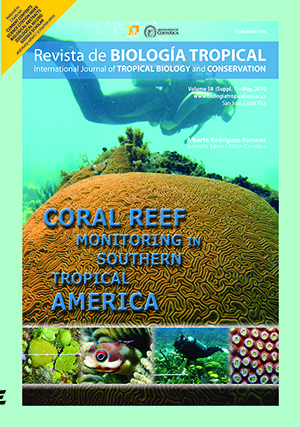Resumen
Este trabajo presenta datos sobre un brote de la Enfermedad de Plaga Blanca (EPB) en el banco de Serrana y resume siete años de observaciones de esta enfermedad en la vecina isla de San Andrés (Caribe colombiano). La mortalidad masiva de corales por causa de EPB se observó en la laguna del atolón (14° 27’ 53.24”, 80° 14’ 22.27” W, y 12m de profundidad) en mayo 4 de 2003. Se encontraron 17 especies muertas o atacadas por EPB y 5.8Ha de parches de Montastraea spp. fueron letalmente afectadas por la enfermedad. En mayo 8 del mismo año observamos y calculamos una cobertura promedio de coral de 7.03% (SD± 2.44), un promedio de tejido coralino enfermo de 5.5% (SD± 1.1) y un 13.4% (SD± 8.05) de coral recientemente muerto cubierto con una fina capa de algas filamentosas; aproximadamente 73% de la mortalidad a causa de la enfermedad ya había ocurrido antes de que terminara el brote de EPB. La EPB ha estado presente en el área de la vecina isla de San Andrés con un bajo nivel de prevalencia pero con esporádicos picos de proliferación de la enfermedad. Durante 1999 y 2004 se observaron incrementos de prevalencia de 266% y 355% respectivamente. Ambientes semi-cerrados como son las lagunas de los atolones y los arrecifes de parche reticulados de Montastraea spp. parecen ser especialmente vulnerables a este tipo de enfermedades coralinas, lo que constituye una alerta hacia una mayor atención y monitoreo en este tipo de ambientes lagunares en atolones.##plugins.facebook.comentarios##

Esta obra está bajo una licencia internacional Creative Commons Atribución 4.0.
Derechos de autor 2010 Revista de Biología Tropical
Descargas
Los datos de descargas todavía no están disponibles.


